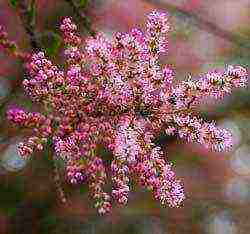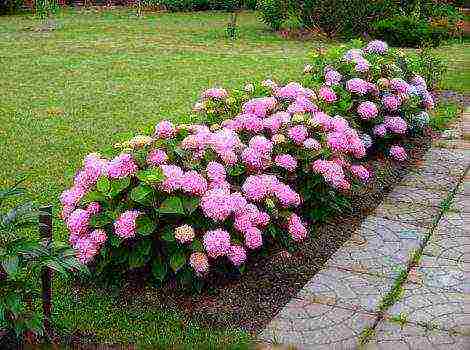Content [show]
 Garden azaleas or, as they are commonly called according to the modern classification of species, rhododendrons are a huge family of flowering shrubs that can seriously differ from each other in size, shades and shape of flowers and even lifestyle.
Garden azaleas or, as they are commonly called according to the modern classification of species, rhododendrons are a huge family of flowering shrubs that can seriously differ from each other in size, shades and shape of flowers and even lifestyle.
Numerous varieties and varieties of cultivated rhododendrons can:
- be evergreen and deciduous plants;
- reach a height of 3 meters and rise above the soil by only 50-60 cm;
- differ in terms of flowering.
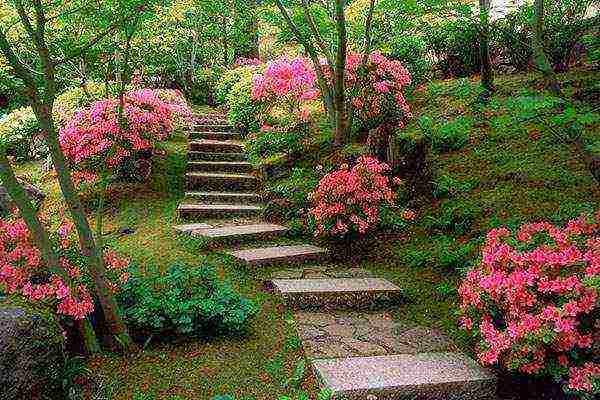 But all of these plants have common features. Garden azaleas have rather graceful shoots, covered with light bark and slightly elongated oval leaves. The leaf plates are small, dense, with a noticeable pile. When the time for the flowering of azaleas comes, from late April to almost mid-summer, flowers with flat or funnel-shaped corollas appear en masse on the tops of the shoots of last year.
But all of these plants have common features. Garden azaleas have rather graceful shoots, covered with light bark and slightly elongated oval leaves. The leaf plates are small, dense, with a noticeable pile. When the time for the flowering of azaleas comes, from late April to almost mid-summer, flowers with flat or funnel-shaped corollas appear en masse on the tops of the shoots of last year.
Depending on the species and variety, you can enjoy a lush cloud of white, yellow, pink, lilac or purple flowers from three weeks to 2.5 months.
Deciduous varieties of garden azaleas have been successfully grown in Russia since pre-revolutionary times, and at the beginning of the last century they were actively used for landscaping and decorating parks near Moscow and St. Petersburg. Today, the selection work of botanists from all over the world has made it possible to easily select plants that, with good care, are very winter-hardy and bloom magnificently, grow in the middle lane.
Growing conditions for garden azalea
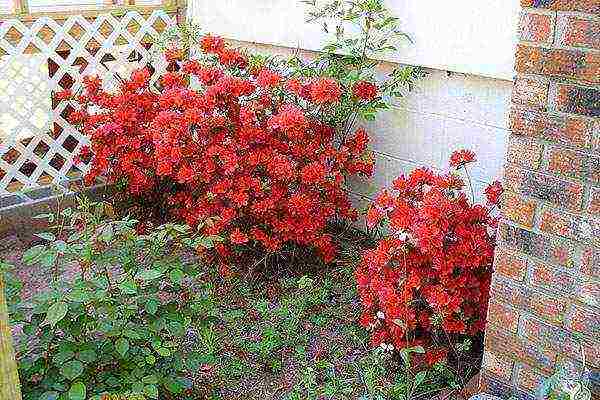 Garden azalea refers to perennial plants with rather slow growth. This should be taken into account when choosing a place for planting a plant and organizing care for a young bush. For the first time, azaleas bloom only 3-4 years after planting, growing up and reaching full development.
Garden azalea refers to perennial plants with rather slow growth. This should be taken into account when choosing a place for planting a plant and organizing care for a young bush. For the first time, azaleas bloom only 3-4 years after planting, growing up and reaching full development.
The ideal temperature for growing a garden azalea in the summer is 20-25 ° C, which is quite acceptable for most areas of the Russian middle zone. In winter, many varieties and hybrids can withstand temperatures as low as 27–32 ° C.
Yet the plant needs protection and year-round support. When planning the planting of a garden azalea, you need to be very careful about choosing a suitable place. In nature, rhododendrons are photophilous, but when exposed to direct sunlight:
- lose decorativeness faster;
- worse form flower buds;
- reduce flowering time.
Therefore, for an azalea, it is better to find a flat area protected from wind and flooding by spring waters in partial shade, where the bush will not suffer from summer heat, frost and gusts of cold air. For planting shrubs near the house, a north, east or west wall is suitable.
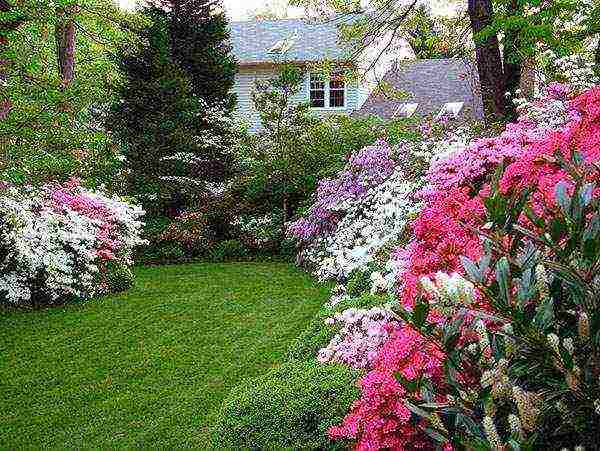 Rhododendrons grow well in the vicinity of larger trees. True, it should be taken into account that the roots of the plants do not interfere with each other. Spruces with a taproot system, small-leaved lindens and oaks feel good next to the garden azalea.
Rhododendrons grow well in the vicinity of larger trees. True, it should be taken into account that the roots of the plants do not interfere with each other. Spruces with a taproot system, small-leaved lindens and oaks feel good next to the garden azalea.
For azaleas, the proximity to garden and park ponds is useful. Here, thanks to the natural humidification of the air, the plant blooms longer, and its foliage remains fresh.
Planting a garden azalea
The best time for transplanting or planting garden azaleas is early spring, when the plant has not begun a period of active sap movement. If, for some reason, rhododendrons are not planted at the beginning of the growing season, this can be done in September. For the remaining warm days and weeks, the shrub will have time to acclimatize and successfully overwinter.
 Azaleas growing outdoors have a superficial root system. Therefore, a deep planting hole for the shrub is not required, but the preparation of a loose fertile substrate is necessary:
Azaleas growing outdoors have a superficial root system. Therefore, a deep planting hole for the shrub is not required, but the preparation of a loose fertile substrate is necessary:
- The depth of the pit may not exceed 50 cm.
- In this case, the width should be 20-30 cm greater than the depth.
At the bottom, a powerful drainage layer is made from fragments of red brick, large expanded clay and sand. It is impossible to use limestone chips, since this mineral gradually changes the acidity of the soil and can cause withering and death of an already established bush of a garden azalea.
The soil removed from the planting pit is cleaned of turf, and then they add to it:
- peat cleared of coarse inclusions;
- humus;
- sand and other components necessary to ensure the looseness and structure of the substrate.
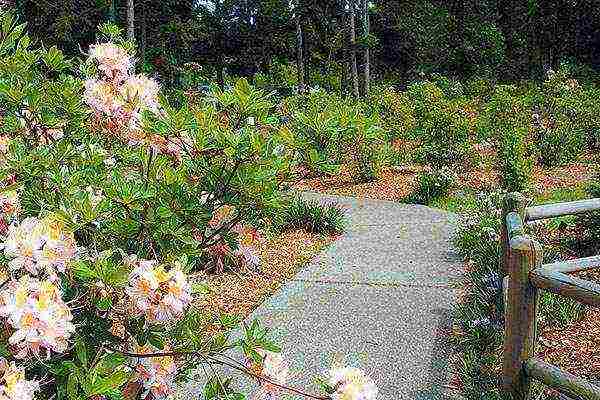 Before immersing the seedling in the pit, a small amount of prepared soil is poured onto the drainage layer in the center. The roots of the bush are carefully laid out on it so that the root collar of the azalea, when backfilled, must remain above the soil level. The soil around the plant is compacted and moistened. If the soil has settled, it is poured over, and the surface is abundantly mulched on top.
Before immersing the seedling in the pit, a small amount of prepared soil is poured onto the drainage layer in the center. The roots of the bush are carefully laid out on it so that the root collar of the azalea, when backfilled, must remain above the soil level. The soil around the plant is compacted and moistened. If the soil has settled, it is poured over, and the surface is abundantly mulched on top.
If you plan to plant a garden azalea purchased from a nursery or store, its root system should first be revived by lowering it into water or watering abundantly before planting.
Seedlings with a closed root system are easier to transplant, while their roots do not need to be cleaned of existing soil, but it is worth checking the health of the roots and removing the damaged ones.
Caring for your garden azalea after planting
 During the entire growing season, garden azaleas need abundant watering. The soil should be moistened immediately after the surface layer has dried. Rain or settled water is best suited for irrigation. To maintain the increased acidity of the soil, citric or other food acid is added to the irrigation moisture once a month.
During the entire growing season, garden azaleas need abundant watering. The soil should be moistened immediately after the surface layer has dried. Rain or settled water is best suited for irrigation. To maintain the increased acidity of the soil, citric or other food acid is added to the irrigation moisture once a month.
On hot days, in addition to the azalea flowering time, the shrubs can be sprayed with warm water to be a good support for the decorative effect of the shrub and prevent insect pests and fungi.
At the end of summer, watering is reduced, provoking the completion of the growth of the shrub and improving its preparation for winter. For the same purpose, the application of dressings is stopped, especially if granular agents of prolonged action were used for this.
Caring for a garden azalea includes mulching, which is designed to protect the roots of the plant from drying out in the summer and frost in the winter. Under such a shelter, weeds develop worse and slower, moisture is saved. A layer of mulch from pine needles, steamed sawdust or shavings, chopped cut grass or even fine expanded clay is replenished and restored as necessary, but does not cover the root collar of the plant.
It is impossible to support a flowering shrub with one watering.Therefore, the azalea is fed at least three times a year.
- In early spring, plants are watered with infusion of mullein or humus.
- Before the beginning of the flowering time of azaleas, in addition to nitrogen, the shrub needs potassium and phosphorus in equal amounts.
- After wilting of most of the inflorescences, the plant is watered with a mixture of phosphorus and potassium fertilizers in a ratio of 1: 2.
Plants of garden azaleas are extremely negative about the introduction of fertilizers into the soil, which contain chlorine and lime. You should not use ash, which is popular with gardeners, for feeding.
Watering and feeding during the care of azaleas is carried out not at the root, but at a distance from the center of the bush at least 20 cm.This technique allows you to bring moisture and nutrients to the most active areas of the surface root system of this garden culture.
Pruning azaleas in the garden
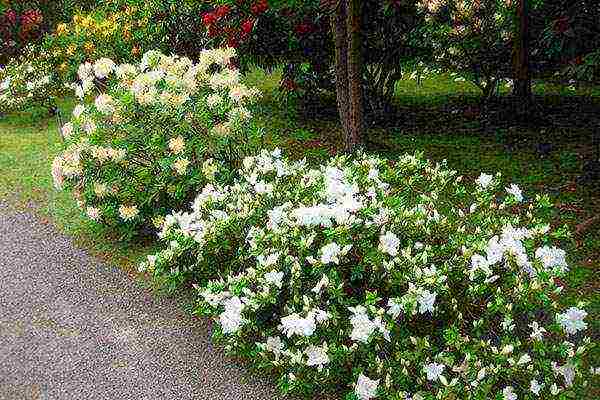 The plant begins spring with already formed flower buds, therefore, after wintering, only sanitary pruning of azaleas is carried out in the garden, when dry and diseased shoots are removed.
The plant begins spring with already formed flower buds, therefore, after wintering, only sanitary pruning of azaleas is carried out in the garden, when dry and diseased shoots are removed.
The formation of a shrub is carried out after the flowers have wilted. During the procedure, both dry peduncles and overly elongated branches are cut off. If you do not remove attention from pruning azaleas for several years, the bush gradually overgrows, the shoots block the access of light and air, which leads to the development of diseases and pests.
When pruning azaleas, it is important to remember that the buds are laid on annual shoots, so this year's growth is not affected. After pruning, large hemp is treated with garden pitch.
Young shrubs up to 3 years of age can not be formed, carrying out only the removal of dead shoots.
Winter care for azaleas
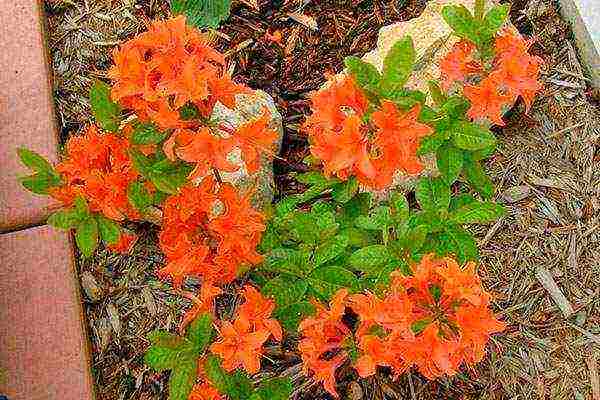 Future flowering depends on the care of the azaleas throughout the year, as well as how the plant overwinters. Certain varieties of garden rhododendrons can survive Russian winters without shelter, but in this case it will not work to guarantee the health of the shrub:
Future flowering depends on the care of the azaleas throughout the year, as well as how the plant overwinters. Certain varieties of garden rhododendrons can survive Russian winters without shelter, but in this case it will not work to guarantee the health of the shrub:
- Flower buds at the ends of the shoots are the first to suffer from the cold.
- With a lack of snow, sometimes not only young branches but also the root system freeze out.
To protect the plants, autumn starts preparing for winter with abundant watering of the soil under the bushes of garden azaleas. Then the root circle is covered with an additional layer of mulch, for which pine needles, peat or fallen leaves are taken. A layer of such protection for small plants can be 5-10 cm, up to 30 cm of insulation is poured under tall bushes.
Branches of deciduous varieties of azaleas growing in open ground:
- gently tilt to the soil;
- fixed with wire;
- covered with corrugated cardboard, special materials or another layer of spruce branches or peat.
It is not worth covering azaleas with film or other airtight materials, since there is a high risk of developing rotting and rotting buds and young shoots.
Azalea evergreens are covered with a pre-made frame so as not to damage the shoots and future buds. Inside the shelter, the plant should not be constrained. And it is necessary to insulate the structure with roofing material or non-woven materials only in the established cool weather, if this is done on warm days, next spring it will not be possible to avoid the loss of some of the flowers.
 Caring for azaleas in winter is to protect plants from wind and moisture condensing during thaws. If the winter is with little snow, the bushes need to be additionally protected by creating man-made snowdrifts at their base. During the rainy season, azaleas are loosely covered with a film, leaving the possibility of moisture escape.
Caring for azaleas in winter is to protect plants from wind and moisture condensing during thaws. If the winter is with little snow, the bushes need to be additionally protected by creating man-made snowdrifts at their base. During the rainy season, azaleas are loosely covered with a film, leaving the possibility of moisture escape.
With the onset of spring, the shelter is removed only after the snow cover melts and the establishment of positive average daily temperatures.
During acclimatization and care of azaleas, they are constantly monitored to avoid sunburn of delicate tissues and wilting of the plant lacking nutrition and moisture.
Garden azaleas are a rewarding culture.Shrubs always respond with lush flowering and growth to adhere to the agrotechnology of growing azaleas in the garden and competent, regular care. No matter where the gardener lives, today you can find many amazing varieties of azaleas that have different colors and different flowering times.
Video about rhododendrons - azaleas in the garden
The rhododendron flower or garden azalea grown in the open field is like a jewel among jewelry. She immediately attracts attention with an abundance of flowers and an exotic look.
Gardeners who decide to stop a conscious choice on a garden azalea should not forget that it is very picky and requires proper attention. Many believe that it is practically unnecessary to keep track of this plant and make a fatal mistake, leading to the death of the flower. Growing a rhododendron is not easy and this process will take a lot of strength and patience from the owner. But if you nevertheless decide to acquire such a gorgeous plant, then you must remember some rules for its care, which will allow you to enjoy the unusual inflorescences of the plant.
Description and general information

In Siberia
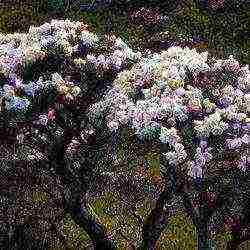
In nature
Azalea can be both an evergreen semi-deciduous or deciduous tree, and a shrub belonging to the Heather family. There are about 1300 species of rhododendrons in the world. This also includes the demanded indoor azaleas, or as it is also called the "Rosewood", because the inflorescences can really be compared with some rosaceous, for example, floribunda roses.
You can meet the plant not only in the garden, but also in the wild. So where does the rhododendron grow? The shrub grows freely in southern China, Japan, North America, the Himalayas, and Southeast Asia. The most common environment where unusual flowers can be found is near rivers, seas and oceans. You can see a miniature bush, whose height will be no more than 30 cm, in addition, you can enjoy the flowering shrubs covering the ground. Each species has original inflorescences, which can have a variety of shapes, colors and sizes. The largest flowers have a circumference of 20 cm.
Varieties and varieties
Rhododendron comes in many varieties and each of them requires a certain amount of care. Some varieties, even in spite of their gigantic size, can freeze in winter or die from lack of moisture in the air. To avoid the loss of such a beautiful plant, each species needs special care.
Some of the evergreens are able to withstand winter without much difficulty. Among them, the following are worth noting:
Evergreen species:

Garden azalea
- Grandiflorum. A shrub that can grow about 2 meters high. Endowed with large beautiful lilac flowers.
- Smirnova "Rhododéndron smirnówii" is a rather lush bush up to 1.5 meters high. Inflorescences of this type are collected together from 10 to 16 pcs. Unusual white buds are painted in a slightly pinkish shade with yellow dots.
- The short-fruited species can grow from 2 to 3 meters high. Most often found with white 5 cm flowers. In nature, it can be found in Japan, Korea, as well as in the Far East.
- A golden or golden-headed azalea, the species is low and reaches only 1 meter in height. 5 cm flowers are collected in inflorescences having an umbrella-shaped shape. Winter hardiness is excellent.
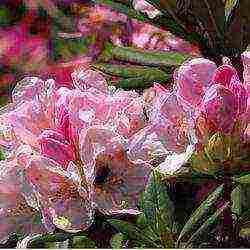
Rosaceae
- The Katevbinsky species is considered to be a large plant, because its height can reach up to 1.5 meters. It begins to delight others with its flowering in May. During this period, the bush is completely covered with lilac-pink buds.
- Daurian or wild rosemary, it can be either deciduous or evergreen. It grows mainly in Siberia. Flowering occurs very early in the first days of May, lilac - pink small flowers.
- Dense or tangled rhododendron.Its width can reach 0.6 meters, and the crown differs from all its predecessors in its incredible density. Straight shoots, very close to each other. The flowers do not have a strong scent. There are three main colors of pink-purple, pale-purple, and lilac-blue. It will take a long time for the bush to reach its maximum size, because this species grows more slowly than other varieties.
- Hellicki. It is a hybrid species characterized by its compactness and density. The height does not exceed 1 meter. Has deep pink inflorescences. Bloom lasts from May to June. Prefers to grow in partial shade.
Among the particularly frost-hardy greens, Haaga, Mauritz, Mikkeii and Peter Tigerstedt should also be highlighted.
Deciduous winter-hardy varieties include:
- Canadian, is a branched shrub up to 1m high. The most beautiful flowers are collected in inflorescences from 3 to 7 pcs.
- Kamchatka view. A small shrub that prefers to grow on the mountain slopes near the sea. Height is about 40 cm. It begins to bloom in May and pleases others with its saturated red 4 cm flowers.
- Azalea Pontic or as it is also called rhododendron yellow. A giant bush with a height of 4 meters and a diameter of about 6 m. Delicate yellow flowers are collected in inflorescences in the shape of an umbrella.
- Japanese azalea looks like a spreading shrub and grows about 2 m tall. The inflorescences include about 6-12 flowers.
- Pukhkansky. It should be attributed to low-growing plants, since it does not exceed 1.5 m. It begins to bloom in May and pleases with its beautiful inflorescences until June.

Yellow rhododendron
Hybrids from the deciduous Light series (white with a yellow spot Nothern Hi-Lights, rare lemon Lemon Lights and orange Mandarin Lights) also do not ignore, they are interesting not only for their exotic look, but also for their delicate pleasant aroma.
Our winters in Russia are too harsh for an azalea, so if you want to decorate your garden with this incredible bush, then, of course, you should consider only frost-resistant varieties of rhododendrons, whether deciduous or evergreen, among the abundance of the arsenal.
It is also worth noting that the Finnish hybrids are much better adapted to the Russian harsh weather conditions than the more gentle Dutch hybrids. This applies even to a very large group of frost-resistant hybrids.
In addition to species groups, there are multiple hybrid varieties:
- Rhododendron Katevba "Boursault" planting and care, which is not difficult. And the beauty of flowering inflorescences exceeds all the difficulties of growing. Blooms purple - reddish in brown dots in large clusters.
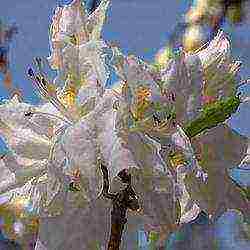
White azalea
- Kalsap is snow-white flowers with a huge maroon area at the very core.
- Adams is notable for the fact that it is included in the Red Book of Buryatia, blooms with pinkish inflorescences, of various shades.
- Scintillation original muted pink bunches of flowers with a greenish throat and red dots along it.
- Nova Zembla "Nova Zembla". It blooms with piercing red buds with a raspberry hue.
- Alfred - has rich - dark purple inflorescences with a golden emerald spot in the center.
- Midnight Mystique. Eye-catching wavy petals of white with a bright crimson stripe along the edge.
- Kiev Waltz lilac - pinkish
- Rhododendron Roseum elegans roseum elegans is a pink subspecies with a slightly purple tint.
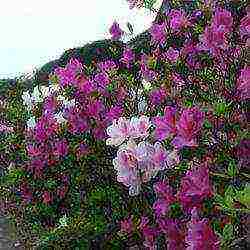
Violet - pink
- Schneegold "Azalea Schneegold" or Pontic azalea, with cream flowers on the top petals of gold spots.
- Cannons Double "Cannon'sDouble" with white-pink buds
- Japanese Azalea Marushka
- Azalea Arabesque is a red beetroot shade.
- Schlippenbach white variety.
- Anneke "Azalea Anneke" yellow azalea.
- Cunningham's White "Rhododendron Cunningham`s White". White rhododendron with reddish-brown blotches.
- Rasputin with extravagant lilac and purple numerous inflorescences.
- Japanese Rosy Lights "RosyLights" during the abundant flowering of pink clusters with pronounced veins, foliage is almost invisible.
- Silver Slipper frost-resistant look with milky flowers, there is a bright golden spot on the top
- Azurro Lilac flowers.
It is especially worth highlighting a number of hybrid subspecies of dwarf rhododendrons:
- Baden-Baden red
- Blue Wonder lavender
- Wren yellowish lemon
- Bengal bright crimson
- Elitte Pink - strawberry
- Inzianna vasilkovo - blue
- Elvira ruby red
- Princess Anne "Princess Anne" soft lemon
- Amethyst salmon shade pink
Absolutely all species, whether dwarf and miniature, or tall and gigantic, will decorate your garden or summer cottage. After all, they are comparable in beauty with the queen of flowers, the rose, but only more exotic.
How to plant and care
- The most suitable period for planting a plant is autumn.
- Do not be discouraged if your plans were to plant a rhododendron in the spring, as you can do this in April or May.
- Do not ignore these tips, since during this period the plant already has time to take root, and the flowers are completing their development.
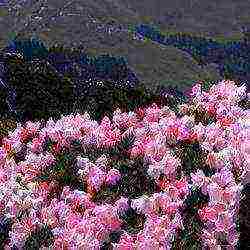
Tree with roses
In order to grow a rhododendron in the garden, he needs to find a site that is covered with branches of tall trees. The fact is that azalea prefers to grow in places where there are no strong scorching rays of light that can harm it. A not very dense crown of trees will create shade, but at the same time it will let in the sun's rays, which the rhododendrum can enjoy.
Before starting planting, prepare a hole in advance that will be twice the size of the root system. Prefers to grow in coarse fibrous peat. If you do not have a significant amount of it or you do not have it at all, then you can use coniferous soil with chopped bark instead.
If you decide to diversify the soil by adding leafy soil to it, then do not forget that it is recommended to use it no more than 30%. The added sand should not exceed 10%. You should not grow the plant in calcareous soil, as it will not be able to survive in it.
How to plant a rhododendron correctly
As mentioned earlier, it is worth preparing a pit in which you will plant a bush. In order for the rhododendron to take root in the Urals, follow these rules.
- To begin with, place the plant vertically in the hole and fill the entire void around the root system with a substrate and press down slightly with your hands, which will avoid the formation of a void next to the roots.
- Do not forget about drainage, as it will help to avoid stagnant water, which means that the root system will not rot and will be provided with sufficient oxygen.
- Mulching the soil with a 5 cm layer, in the area where the roots are located, is an important step. For this, foliage, needles or peat are used. After the mulch has been laid, it is necessary to thoroughly water the plant so that the water penetrates to the entire depth of the created hole.
- Sometimes it happens that the plant has to be planted during the period when it blooms. In order for it to take root for sure, it is necessary to rid it of some of the buds. After planting, a support should be created that will allow the plant to take root and prevent strong winds from damaging it. Once the rhododendron has taken root, the supports should be removed.
How to properly water rhododendum
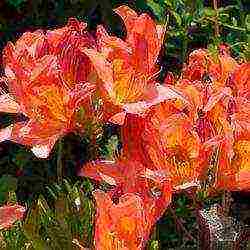 If you want the buds to form correctly, it is necessary to water the plant in a timely manner. In addition, only settled or rainwater is used for irrigation. In order to make the water softer per day, several handfuls of high-moor peat are added to it.
If you want the buds to form correctly, it is necessary to water the plant in a timely manner. In addition, only settled or rainwater is used for irrigation. In order to make the water softer per day, several handfuls of high-moor peat are added to it.
Whether the rhododendron needs watering or not should be determined by its foliage.
If you notice that it has lost its luster and has become dry, then the plant indicates that it needs to be watered.
When moistened, the soil should be soaked about 20-30 cm in depth. But remember that in no case should you overflow the bush, as it does not like excessive moisture. If the plant experiences excess moisture, then its foliage will curl up and fall. To preserve the bush in the summer, you need to spray its foliage, which will avoid excess moisture.
Do I need to trim
Like any plant, rhododendron must be pruned, but basically this procedure is carried out only with young bushes, which helps to give them a beautiful shape. To do this, pinch the stem next to the central bud. Of course, if the plant has lost its shape, and its crown has become too large, then it is necessary to carry out a standard pruning of the shoots.
Branches whose diameter is about 24 cm must be removed from the plant. All slices are processed. For this, oil paint or soda var are suitable, which do not allow the plant to get sick.
Lush flowering of rhododendrons video:
What fertilizers to use
In order to know for sure that your plant requires fertilization, pay attention to its appearance:
- The foliage will become much lighter than it was before.
- May start to fall
- Loses its natural shine.
- Also, much less young shoots will form on the bush.
- The buds will not form.
All rhododendrons need constant feeding regardless of when exactly they were planted.
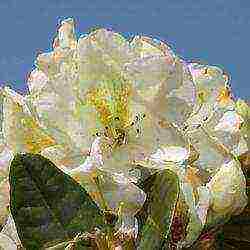 The first time to feed the bush is in March, while the last time it must be fertilized at the end of July, when the flowering has already ended, and new branches have begun to appear on the bush.
The first time to feed the bush is in March, while the last time it must be fertilized at the end of July, when the flowering has already ended, and new branches have begun to appear on the bush.
This plant loves liquid fertilizers, which can be both semi-rotten cow dung and horny flour. If you decide to stop at the first type of fertilizer, then it should be diluted with water a few days before use, observing a ratio of 1 to 15. Be sure to water the plant, before proceeding with the introduction of feeding, after the procedure carried out, you need to water it again.
Azalea gardeners use some tricks to help the soil acquire the right acidity.
To do this, they use:
- nitrate or potassium sulfate,
- superphosphate,
- magnesium sulfate or ammonium.
Parasites and diseases that can affect the rhododendrum
 Mealybugs, scale insects, spider mites, bugs, weevils, rhododendron flies, snails or slugs can all attack your precious bush.
Mealybugs, scale insects, spider mites, bugs, weevils, rhododendron flies, snails or slugs can all attack your precious bush.
In order to get rid of gastropods, you first need to collect them manually, and then carry out prophylaxis with the fungicide TMTD or Thiram.
To save the plant from spider mites and bedbugs, treat it with diazinon.
Also, if a weevil turned out to be a pest, be sure to treat the land around the rhododendron using an insecticide for this.
Karbofos will help get rid of the remaining pests.
Advice!
To avoid any diseases, it is imperative to treat the plant with Bordeaux liquid in late autumn and March.
All diseases that attack rhododendron, as a rule, arise due to the fact that moisture and oxygen does not get well to the roots.
The most common ones will be:
- crayfish
- chlorosis
- leaf spot
- rust
Copper sulfate will help rid the rhododendron of stains and rust.
In order for the plant to be able to save itself from chlorosis, add iron chelate to the water you water it with.
If the azalea is defeated by cancer, then you need to cut off all the branches that were infected, leaving only healthy shoots.
How to propagate a rhododendron
As a rule, two main methods are used for breeding:
-
Cuttings.
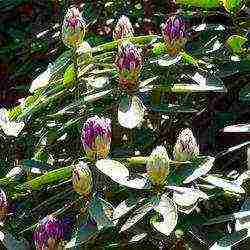 In the middle of summer, it is necessary to cut the cuttings, the length of which will be from 10 to 15 cm, not forgetting to get rid of the lower leaves. Place them in a liquid that will promote root formation for a day.
In the middle of summer, it is necessary to cut the cuttings, the length of which will be from 10 to 15 cm, not forgetting to get rid of the lower leaves. Place them in a liquid that will promote root formation for a day.
Prepared cuttings are planted in pre-prepared soil, consisting of peat, sand mixture and coniferous soil, and then covered with a film.
After this procedure is done correctly, the roots will form no more than 3-4 weeks.
In September, transfer the formed sprouts to suitable containers and leave them for the winter in the cellar or basement. At the end of spring, it can be planted, the buds should be removed in a prepared place. And only next spring will the main growth of rhododendron go and the possibility of full flowering.
-
Layers.
Find the most suitable branch that will be as low as possible to the ground and make a small cut in it. This stem must be laid in a special hole, secured with wire and, of course, covered with peat. The land where the cuttings are located must be constantly moistened, which will allow the roots to appear by autumn. After waiting for spring, separate the future bush from the uterine rhododendron and plant it on an area where it will constantly grow.
How to prepare a shelter for winter
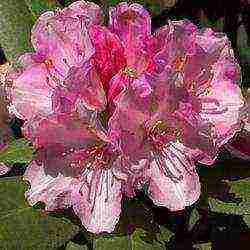 It is possible to start preparing for winter from November, because the temperature is gradually decreasing and the threat of frost and snowfall is increasing, which can break branches.
It is possible to start preparing for winter from November, because the temperature is gradually decreasing and the threat of frost and snowfall is increasing, which can break branches.
From how the plant will endure the winter, its flowering will come. There are deciduous and evergreen rhododendrons and all different in winter hardiness. If you don't want to risk your pet, you should build a shelter, especially young specimens, even frost-resistant ones.
The bush must be covered with roofing material or some kind of frame shelter should be used for this purpose. Heavy snowfalls and strong winds cause significant damage to the bush. To prevent azaleas from freezing, experienced flower growers construct special protective structures from polyurethane or polypropylene foam.
You can clean up the shelter somewhere in April, do not delay too much with this, so that the handsome man does not pry on you, having previously chosen a cloudy day, as if preparing the plant for the external environment and not getting sunburn.
Combination with other plants in the landscape
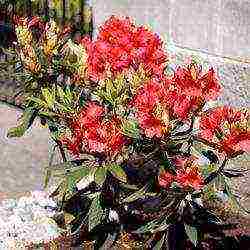
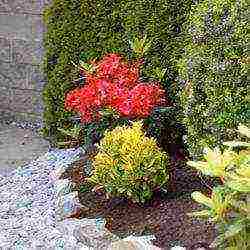 No garden decorated in Japanese style will look beautiful without rhododendron among the many plants. It looks harmoniously next to exotic maple, bamboo and a variety of conifers, which allow you to focus on the unforgettable rhododendron during flowering. In Europe, this gorgeous bush is planted close to spireas, hydrangeas and keria.
No garden decorated in Japanese style will look beautiful without rhododendron among the many plants. It looks harmoniously next to exotic maple, bamboo and a variety of conifers, which allow you to focus on the unforgettable rhododendron during flowering. In Europe, this gorgeous bush is planted close to spireas, hydrangeas and keria.
Rhododendron can live next to oak, larch and pine, as well as other trees, whose roots are directed deep into the earth. Those trees, whose root system is located at the same depth as that of the rhododendron, will take away all nutrients from it, and will not allow it to develop. If the planting site is nevertheless located next to such trees as chestnut, alder, maple, linden and willow, then you need to carry out a special procedure that will protect the roots of your plant. To do this, you need roofing material, slate, or polyethylene, which are dug into the soil. Next to an apple tree and a pear, the bush will feel great.
You can grow a rhododendron in any region of Russia, including the Moscow region, the Urals and Siberia, the main thing is not to forget to take care of it in a timely manner and follow all the necessary rules.
Rhododendrons in landscape design video review
Garden azalea (Latin azalea) is a perennial plant with a rather slow growth. This must be borne in mind when choosing a place for planting a crop and carrying out further care for it. The first buds appear only in four-year-old bushes.
According to the botanical description, azalea can reach a height of 50 cm. The plant's temperature requirements are acceptable for most Russian regions. There are some hybrids that can withstand temperatures below -27 degrees.Despite its unpretentiousness, the garden azalea requires year-round protection and care measures.
1 Popular varieties
All the varieties of garden azalea known today come from two types:
- Indian azalea. It is a bushy plant that sheds leaves. Reaches a height of up to half a meter. On the surface of the bushes there are leathery leaves up to 4 cm in length, pubescent with reddish villi. Their plate is greenish, on the inside it is lighter. Indian azalea produces simple or double inflorescences. The color range is extensive - from snow-white to scarlet. Often there are varieties with a two-tone color.
- Japanese azalea. An evergreen plant that can withstand cold temperatures in winter. It is a sprawling bush that begins to bloom in May. Its leaves are large and glossy, up to 5 cm in diameter. Flowers are funnel-shaped, multi-colored.

Indian
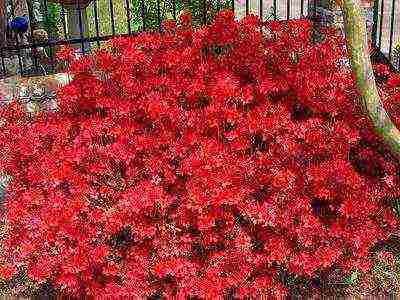
Japanese
There are several other common varieties.
Liatris: care and planting in open ground
1.1 Kermesina Rosa
Adult crops reach 80 cm in height. Their width reaches 1 m. Flowers have the form of a bell with a two-color color. They have it bright pink interspersed with a burgundy hue. The edging of the petals is lighter. Blooms from May to June.
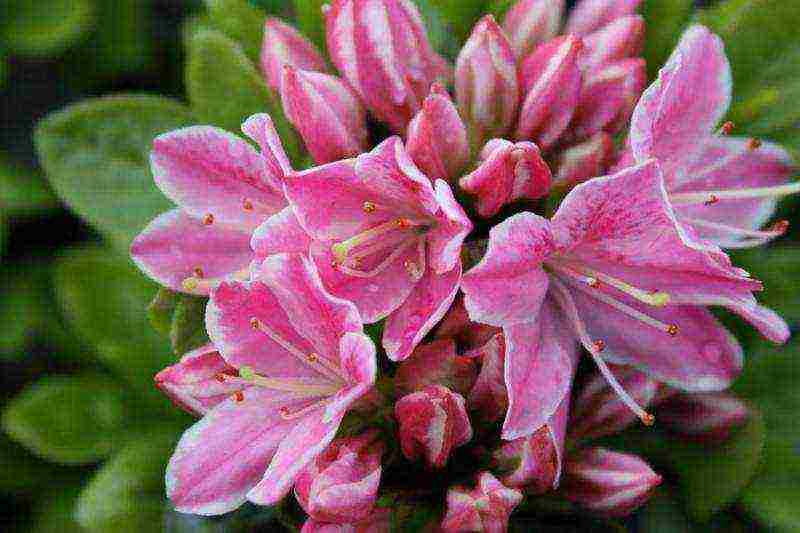
Hyacinths: planting in open ground, plant care, forcing rules
1.2 Esprinsessin
The bushes reach a height of 30 cm. The crown in diameter can be up to half a meter. The first flowers appear in May. They are terry, white with a pink center.
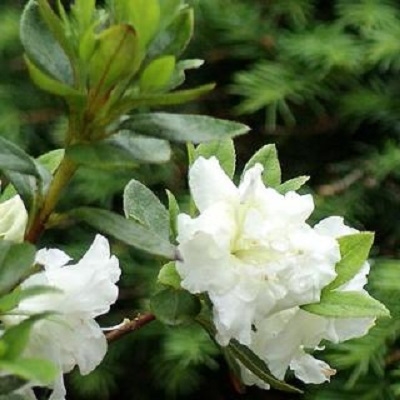
Clematis: planting in open ground and care features
1.3 Adonis
Blooms in May. The leaves are elliptical, olive green, glossy. It grows slowly. The flowers of such a shrub are snow-white, collected in inflorescences. The plant lives for a long time, up to 10 years.
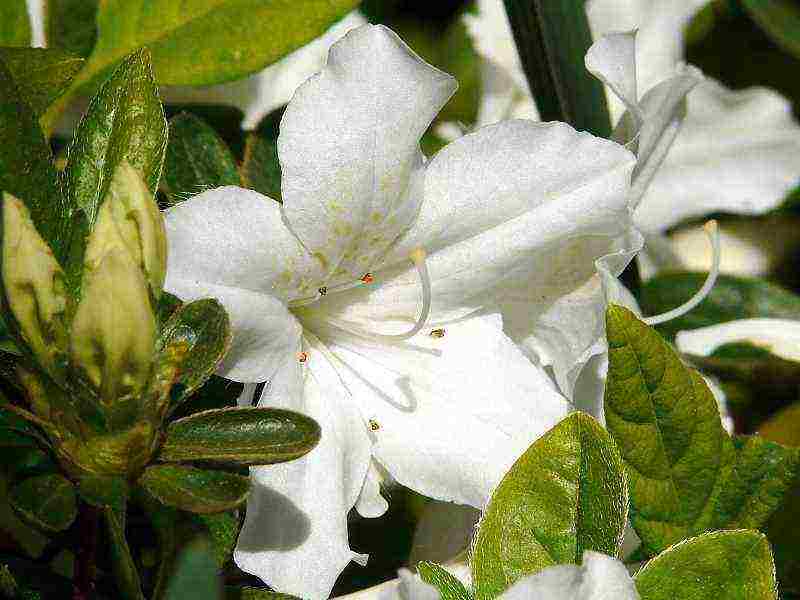
1.4 Geisha Orange
The bushes grow up to 50 cm in height. Their width can be up to 70 cm. The flowers are orange, have the appearance of a bell, concentrated on the tips of the shoots.
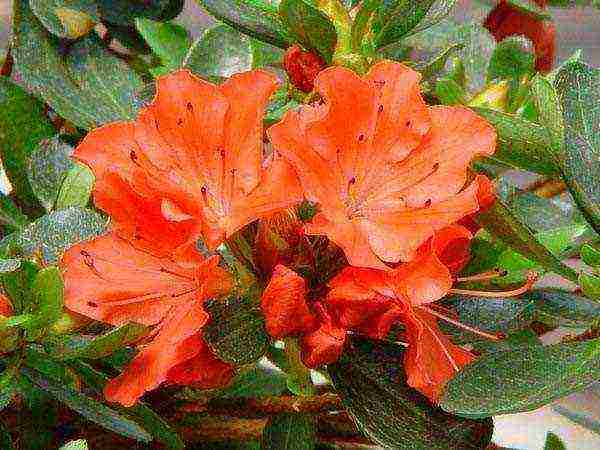
Blooms from May to June for a total of 3 weeks. The crown is formed from a large number of short shoots covered with dark leathery leaves.
2 Choosing a location
Garden azalea is a winter-hardy variety, so it can be grown in any region of Russia, including the Moscow region, the Urals and Siberia. There are no fundamental differences regarding planting a plant and further caring for it in these areas. The planting process begins with choosing the right place in the garden. It is not so much the region that is important as the microclimate prevailing in a particular area. A number of conditions are taken into account that are necessary for the successful survival of the seedling in the open field:
- The lack of the possibility of direct sunlight in combination with a large amount of light. If this condition is not met, the plant quickly stops producing buds, and the flowering period is shortened. At the same time, the leaves also suffer, become shriveled.
- For evergreen varieties, areas with partial shade or diffused light are most suitable.
- For deciduous species, planting on the soil under the canopy of large trees is recommended, provided that the roots of the plants do not interfere with each other's further growth. Suitable companions for bush azaleas are larch, yew, spruce, oak. Poplar, maple, alder have a root system, which for the most part develops in the surface layers of the soil. They take food and moisture from the nearby plants, and therefore the neighborhood with them is undesirable.
- When disembarking near buildings, you can choose any side, with the exception of the southern one.
- For outdoor azaleas, areas with flat relief are suitable. With the onset of spring, water does not stagnate in such areas due to melting snow. Draft protection must be provided. Crop should not be planted between buildings and at the corners of buildings.It is good if there is an artificial or natural reservoir nearby. Humid air helps keep foliage fresh and bloom for a longer period.
Temperature marks at which the garden azalea feels as comfortable as possible are + 20 + 25 ° С. Almost all regions of central Russia correspond to these indicators. In the cold season, plant varieties are able to withstand marks down to -27 ° C. But if the temperature drops below this figure, the flower will die.
Group planting is the best option for gardeners who want to give maximum decorative effect to their backyard plot. Do not plant deciduous and evergreen varieties nearby. For tall varieties, it is better to highlight the center of the plot. Its near edge is more suitable for undersized ones.
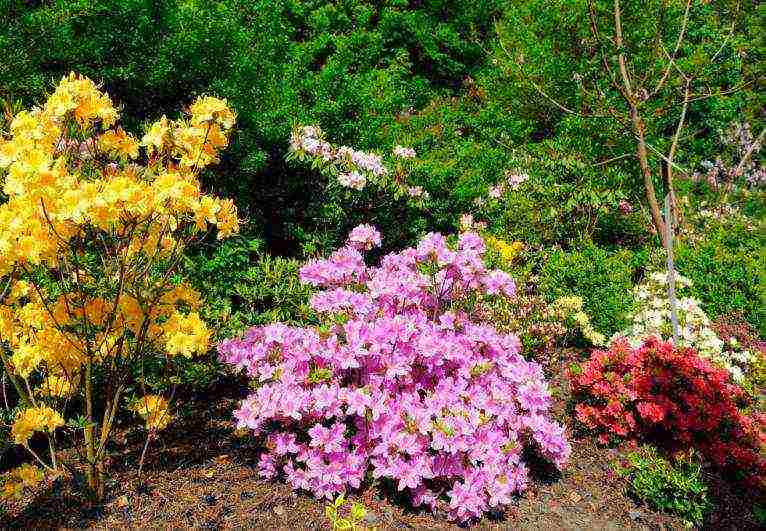
Tall species of garden azalea are best placed in the center of the site, and low-growing ones - at the edges
When choosing plants, it is recommended to take into account the color of the buds. Varieties with orange flowers look good with yellow ones, purple ones with pink ones, white ones with reds.
3 Soil requirements and planting
Japanese azalea grows well only on sour and loose soils. Peat, sand, coniferous soil must be present in the soil. Its acidity should always be in the range of 4.0-4.5. For planting a seedling, the beginning of spring or autumn is recommended. In the first case, the plant sap does not start moving. Landing in early September is good because the bush manages to take root in a new place before the cold weather begins. For this reason, it tolerates winter frosts.
The garden azalea has a superficial root system. For this reason, it makes no sense to equip a deep hole for it. And yet, planting seedlings involves some conditions:
- The depth of the planting pit should be 0.5 m and the diameter 0.7 m.
- At the bottom, a drainage layer with a height of 20 cm should be laid. It should consist of expanded clay, sand and broken brick. The last component is intended to acidify the soil. It is undesirable to use crushed stone for these purposes, since this lime material leads to alkalinization of the earth. Azalea can't stand it.
- The soil dug out of the hole must be mixed with humus, peat and coarse sand. This measure increases soil looseness and permeability.
- On top of the drainage layer, the soil mixture must be poured in a slide. It is necessary to install a seedling on it.
- The root ball must be carefully covered with soil and compacted around the plant. If necessary, add some earth and water. The level of the root collar should be slightly higher than the soil level.
- The soil around the bush must be mulched with peat or chopped bark. Such a measure will not allow weeds to grow and retain life-giving moisture in the ground.
Plants placed in a container can be planted throughout the summer. But, removing the bush from the container, you cannot shake the ground from the roots. If the crop was purchased from garden centers or nurseries, it must be properly watered before planting. You can dip the root ball into the water for a while and wait until air bubbles appear on its surface.
It is better to buy seedlings in a volumetric container, the dimensions of which correspond to the size of the plant. Roots in small containers do not develop enough.
It is important to check the viability of the seedling in advance. The branches of the bush must be strong and healthy. You shouldn't expect to be able to get out of a weak culture.
4 Mulching and fertilizing
For mulching bushes, crushed pine bark, fallen needles, small expanded clay are used. For this purpose, you can also use steamed sawdust, tree foliage, with the exception of maple and chestnut crops. Carrying out this procedure, you need to ensure that the root neck remains free.
Top dressing is required: without them there will be no abundant flowering.Supplementary nutrition ensures normal growth of the azalea. In total, fertilizers are applied during the summer several times:
- Humus solution - used in spring. A ratio of 1 to 10 is recommended.
- The next feeding with humus is carried out at the beginning of bud formation. Preparations based on phosphorus and potassium are added to the main composition.
- After the last flowers fall off, the azalea is fed with phosphorus and potassium in a ratio of 1 to 2.
Top dressing is applied at a distance of 0.3 m from the central part of the bush. When using complex fertilizers, it is necessary to ensure that the composition does not contain lime and chlorine. Wood ash won't do any good either. It changes the acidity of the soil downward.
5 Watering, weeding, spraying
Throughout the summer, the azalea needs abundant watering. If the surface of the soil is slightly dry, this means that another wetting is required. They use settled or rainwater for this. Once a month, you can add a teaspoon of citric acid to 2 liters of water. This measure increases the acidity of the soil. As soon as autumn arrives, watering is reduced. This is necessary so that new shoots do not form. They do not have time to ripen before the cold weather and freeze. In order for the culture to endure frosts with minimal losses, abundant watering is carried out before the beginning of December.
Azalea has a favorable attitude towards spraying. Moist air increases the decorative properties of the crop and acts as a prophylaxis against harmful insects. At the time of flowering, spraying is excluded: it can lead to the formation of ugly spots on the buds.
Weeding is done several times during the growing season. Manipulation should be done with care so as not to injure the superficial roots of the azalea.
The transplant is done according to the same principle as the landing. It is held in early spring. Around the transplanted bush, they arrange a side of soil or moss to protect the roots from frost in winter.
6 Cropping
Successful cultivation of a culture at home is impossible without proper pruning of the bushes. This process is carried out in several stages:
- In the spring, sanitary pruning is carried out, when dry and diseased shoots are eliminated. The rest of the branches do not touch, because flower buds have formed on them since autumn.
- Throughout the entire flowering period, wilted flowers are actively removed.
- As soon as the last buds wither, formative pruning is carried out. Its essence lies in the fact that dry peduncles are removed, and excessively long shoots are shortened. Such branches are also removed, which give excessive density to the bush.
- All other shoots should be shortened by no more than a third of the length. If you adhere to these rules, next year the culture will turn into a lush flowering plant. It is important to cover the cuts with garden varnish or varnish-based paint. Manipulations must be carried out with protective gloves, because azalea juice is poisonous.
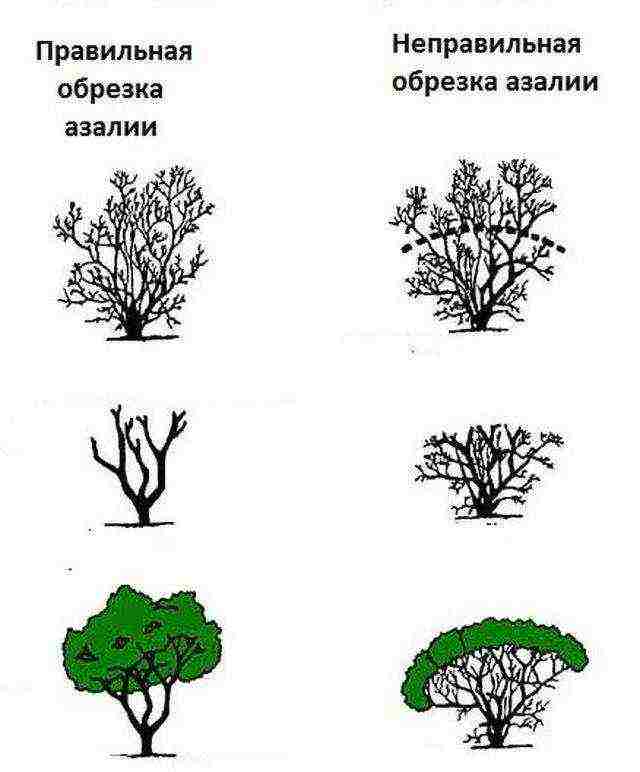
Scheme of pruning azalea garden
Azalea reaches maturity at 4 years of age. For this reason, not the formation of young bushes is carried out, but only their sanitary pruning.
7 Pests and diseases
Garden azalea is susceptible to fungal infections. Leaf spot, rust, rot are often found in her. Spraying with copper sulfate and treatment with fungicides help to effectively cope with them. As a preventive measure, it is possible to recommend the treatment of bushes once a season with Oxyhom. The foundation solution is used after flowering.
The full growth and development of azaleas are hindered by such pests as spider mites, mealybugs, whiteflies, black thrips. Insecticide solutions will help to cope with them.
The formation of calcareous chlorosis is indicated by the appearance of light areas on the leaves. Over time, they turn yellow.
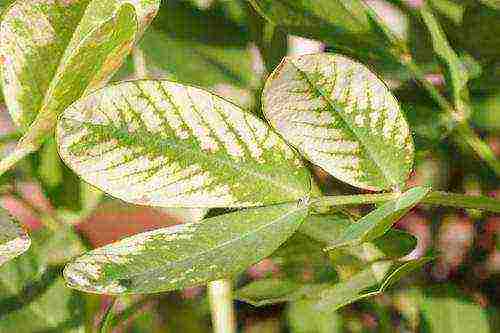
Leaves affected by calcareous chlorosis
The use of special solutions applied under the soil helps to cure the disease. They increase the acidity of the soil. These include apple cider vinegar and table vinegar. They are taken with the calculation of 100 ml per 10 liters of water. Oxalic and citric acid also have proven effectiveness. They must be used in the amount of 2 tbsp. l. 10 liters of water.
7.1 Lack of buds
If the garden azalea does not bloom, the reason for this may be:
- alkaline soil;
- insufficient amount of scattered light;
- lack of water;
- too hot air;
- lack of nutrition or too abundant feeding.
8 Reproduction
Perennial propagates by cuttings, layering, seeds, dividing the bush. The choice of this or that method depends on how fast the result the gardener wants to get. The easiest way is to lean the side shoot against the ground, secure it with wire, sprinkle it with soil and start regular watering. After a while, the plant will take root. Next spring, the new bush will need to be separated from the main plant.
The division of the bushes is carried out in the spring, when the juice has not yet begun to move along the stem. Take a spatula or any other sharp object, separate part of the stem with it. After that, it is necessary to plant the escape in a new place. The mother shrub should have a strong root system and 2 or 3 healthy shoots.
Reproduction by cuttings takes from one and a half to four months - from the moment of cutting the cuttings to their complete rooting. Experienced gardeners recommend the following algorithm:
- Cut off a 10 cm stalk from the top of the plant. Remove the lower leaves and apical bud, leaving 2 or 3 healthy leaves.
- Treat the cut sites with a special growth stimulant.
- Deepen the cuttings by 3 cm into individual containers, for example pots. First, they must be filled with a mixture of sand and peat, after which the soil must be moistened.
- Cover the containers with cut-off plastic bottles. Get miniature greenhouses. A week after planting the cuttings, it is necessary to start airing. To do this, it is enough to unscrew the caps or remove the entire bottles for 15 minutes.
To ensure successful rooting, it is necessary to ensure that the air temperature does not drop below +20, and water if necessary. Excess water must be drained from the pan in a timely manner.
Once the cuttings are rooted, transfer them to a container with fertile soil. After a year, the seedlings can be planted in a permanent place in the garden.
Gardeners almost never use seed propagation. The fact is that it assumes a long waiting period for the first flowering.
9 Preparing for cold weather and spring care
The buds, which will appear next year, are laid in the fall. That is why it is important to ensure the safety of the plant during the winter and help it to endure frost with minimal losses. Many varieties are resistant to low temperatures. But for maximum reliability, it is better to cover the shrub for the winter. To ensure the safety of young branches and flower buds, you need to follow a few more rules:
- Mulch under the bushes with a layer of 5 to 10 cm.Under tall crops, the mulch layer can be up to 30 cm.
- Bend the branches of deciduous varieties to the ground and secure with wire. It is necessary to equip a multi-layer shelter, consisting of spruce branches, corrugated cardboard, covering materials.
- Do not use polyethylene when organizing winter protection. The same goes for other materials that are impervious to air: this will lead to rotting of the shoots and buds. For evergreen varieties, a frame should be made. It must be placed before the soil freezes. The covering material is pulled onto the base only after stable cold weather has been established.
To insulate the frame, roofing material and other durable materials are used - so that there is a distance of 25 cm between the bush and the walls of the ceiling.To remove moisture, a flexible hose is laid under the building.Its opposite end is brought out. With the onset of spring, do not rush to open the bushes. We must wait for the complete melting of snow on the site. Plants that have managed to wean themselves from sunlight will not immediately get used to the spring rays. For this reason, they must be opened for a limited period. It is best to do this in the morning, gradually increasing the duration of the sunbath.
 According to the modern classification, the garden azalea is called rhododendron. This family includes a large number of species that are distinguished by their beauty and splendor of flowering. All these varieties can have significant differences among themselves:
According to the modern classification, the garden azalea is called rhododendron. This family includes a large number of species that are distinguished by their beauty and splendor of flowering. All these varieties can have significant differences among themselves:
- Shrubs can be deciduous or evergreen.
- Be in height from half a meter to three meters.
- Differ in terms of flowering time.
Garden azalea grows in temperate climates... Some rhododendron varieties can only grow in cold regions. The height of the plant and the diameter of the calyx of the garden azalea can vary considerably.
The classic garden azalea looks like this:
- The shoots of the plant are very delicate and fragile and covered with scales. Such branches are very easily exposed to mechanical damage and require special care.
- Japanese azalea sprouts are covered with light thin bark.
- The leaves of the plant are traditionally oval in shape. When it comes to hybrid varieties, the leaf can be round or carved.
- Garden azaleas grow both in groups and as individual shrubs.
- Inflorescences can be monochromatic or multi-colored. Flowers can be simple, fringed or double.
Conditions for growing garden azalea - choosing a planting site
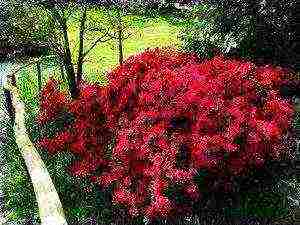 The main condition for the successful cultivation of this ornamental garden shrub is the right choice of planting site. On the bush should not get in direct sunlight. It is best to choose a shaded area in your garden. However, in the thick shade of the azalea it will also be uncomfortable. The plant needs diffused sunlight.
The main condition for the successful cultivation of this ornamental garden shrub is the right choice of planting site. On the bush should not get in direct sunlight. It is best to choose a shaded area in your garden. However, in the thick shade of the azalea it will also be uncomfortable. The plant needs diffused sunlight.
The best place to plant a garden azalea is on the north side of the house. In such a place, the plant will be illuminated by the sun in the morning and afternoon.
When choosing a place to plant Japanese azalea, it should be borne in mind that different varieties need different degrees of shading. An evergreen plant needs constant diffused lighting. Deciduous varieties feel very comfortable in the shade of trees when the sun's rays break through the crowns.
Neighborhood with other plants plays a significant role. Best of all, garden azalea is adjacent to larch and oak. It is not recommended to plant shrubs next to maple, poplar, linden - the roots of these trees go shallow into the ground and will pick up moisture from the rhododendron. If it is not possible to settle the plants far from each other, you can isolate the roots with a waterproof film or roofing material.
It is very important to protect the rhododendron from wind and drafts. Do not plant shrubs at the corner of a building or in areas that are blown through between buildings.
A good solution would be a site near a natural or artificial reservoir - in such places the air always has sufficient humidity. However, the site should not be allowed to flood during the spring thaw.
How to plant an azalea
It is best to choose a variety for planting based on the characteristics of your personal plot..
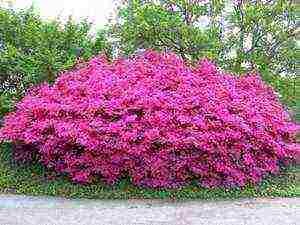 When buying seedlings, carefully familiarize yourself with their agrotechnical characteristics.
When buying seedlings, carefully familiarize yourself with their agrotechnical characteristics.- It is best to purchase a plant in a spacious container with a large earthy clod. If a young plant is in a cramped container, its root system will be underdeveloped.
- If the potted medium is dry, the plant may not take root in your garden.
- The branches of a young plant should be firm and healthy. A seedling with weak shoots will not be viable.
By purchasing a seedling, you need to make sure that the plant has grown well to the soil.To do this, you can gently pull on the base - a healthy seedling will be pulled out of the pot along with an earthen lump.
It is also necessary to properly prepare the soil before planting in the ground. To do this, dig a hole 50 cm deep and 70–80 cm in diameter. Drainage is poured at the bottom with a layer of 20 cm. You can use broken brick with sand. Do not use lime compounds as drainage - they can alkalize the soil unnecessarily.
The acquired plant is removed from the container and placed in a hole along with an earthen lump. Beforehand, you should thoroughly moisten the roots. If the soil in the container is dry, the earth ball should be submerged in water and wait until the bubbles stop coming out.
The plant is placed in the pit in such a way that the top of the earthen ball is at the level of the upper edge of the pit. The remaining space is covered with soil... The surface is slightly compacted.
Outdoor plant care
The rules for caring for a rhododendron in the open ground at a summer cottage are as follows:
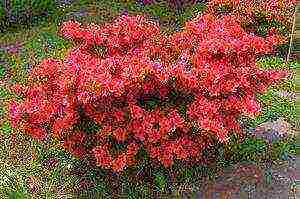 Water the plant abundantly as soon as the topsoil dries up. For irrigation, they use settled water, you can rain or from a pond. In August, you need to drastically reduce the amount and frequency of watering to give the plant the opportunity to prepare for the dormant period.
Water the plant abundantly as soon as the topsoil dries up. For irrigation, they use settled water, you can rain or from a pond. In August, you need to drastically reduce the amount and frequency of watering to give the plant the opportunity to prepare for the dormant period.- You can slightly acidify the soil monthly. To do this, take the juice of 5 lemons and 5 liters of water. For a young plant, 1.5 liters of solution will be enough, and an adult will need 2.5 liters.
- Mulching can be done with dry foliage and pine needles. Do not use chestnut and maple leaves - they have an alkaline reaction and decompose very quickly. In summer, a layer of mulch will protect the roots from drying out and overheating, and in winter - from freezing. Do not cover the root collar of the shrub with a layer of mulch. A layer of mulch can be added as needed.
- Pruning of garden azaleas is carried out as needed - all dried and damaged shoots and wilted inflorescences are removed. Places of removal are treated with linseed oil or garden varnish. If all the shoots of the plant are healthy, pruning can be omitted. Correction of the crown is necessary only for old shrubs and only after the end of flowering. Avoid pruning in the spring before flowering. You can remove shoots with formed flower buds.
- Garden azalea loves moist air, so it needs regular spraying. You can simply place a barrel of water in the garden next to the bushes. Do not spray the bush during flowering - water gets on the flowers and damages them. You can do without additional care and watering in autumn or rainy summer.
- You can feed the deciduous azalea in the spring - for this, a mullein solution is used. The second feeding is carried out before the onset of the flowering period. At this time, a mixture of mullein and potassium with phosphorus is used. You should not use pig or horse manure for fertilization - only cow manure. Imported granular fertilizers are not suitable for growing azaleas in the Russian climate - they are designed for six warm months a year and can lead to freezing of immature shoots. Wood ash is also not suitable for fertilization - it is capable of leaching the soil in the garden.
Diseases and pests
Azalea in the garden can be affected by the following diseases:
 Calcareous chlorosis is the most common ailment of this ornamental shrub. The shrub leaves brighten at first, and then begin to turn yellow. Top dressing with peat and acid mixtures will be a good preventive measure.
Calcareous chlorosis is the most common ailment of this ornamental shrub. The shrub leaves brighten at first, and then begin to turn yellow. Top dressing with peat and acid mixtures will be a good preventive measure.- Often, azalea is affected by fungal diseases - rust, rot, spotting. It is necessary to treat these diseases with fungicidal agents.
- The defeat of necrosis can occur with a sharp cold snap during the growing season and is expressed in the appearance of brown spots on the leaves.
- With the defeat of Fusarium, yellowing and wilting of the stems of the rhododendron are observed. This condition can be treated with Fundazole.
- If the plant lacks sunlight and timely pruning is not carried out, it can get sick with septoria. This disease is characterized by reddish-yellow patches on foliage and stems. You can cope with this ailment with the help of a fungicide.
 For the prevention of diseases, rhododendron needs to be treated with "Hom" or "Oxyhom" products. These preparations are used before flowering begins. At the end of the flowering period, a foundation is applied.
For the prevention of diseases, rhododendron needs to be treated with "Hom" or "Oxyhom" products. These preparations are used before flowering begins. At the end of the flowering period, a foundation is applied.
The most common pests of azaleas are rhododendron mites, spider mites, mealybugs, aphids and black thrips. If signs of parasite infestation appear, insecticidal agents should be used.
Very often, novice gardeners are faced with the question of why azalea does not bloom. Most likely, this is due to a violation of the rules of care - the plant lacks sunlight or moisture in the garden. The air temperature may be too high for a rhododendron.
Wintering and transplanting garden azalea
 In the autumn, flower buds are laid at the plant. How the azalea blooms directly depends on the quality of wintering. The plant must be prepared for winter in the most careful way. In the fall, before freezing the soil, the shrub should be thoroughly watered.
In the autumn, flower buds are laid at the plant. How the azalea blooms directly depends on the quality of wintering. The plant must be prepared for winter in the most careful way. In the fall, before freezing the soil, the shrub should be thoroughly watered.
In order for the plant to have time to prepare for winter, you should not carry out top dressing in the fall.
Cover the root zone for the winter a protective layer of peat, pine needles or foliage. A layer of 5-7 cm will be enough for young plants. For adult tall shrubs, a layer of insulation of 20-30 cm is required.
Transplanting the azalea is best in the spring. If you did not have time to do this, you can transplant the rhododendron immediately after flowering, but no later than September. Since flower buds are laid in the fall, it is not necessary to expect active flowering the next year after transplantation.
>
